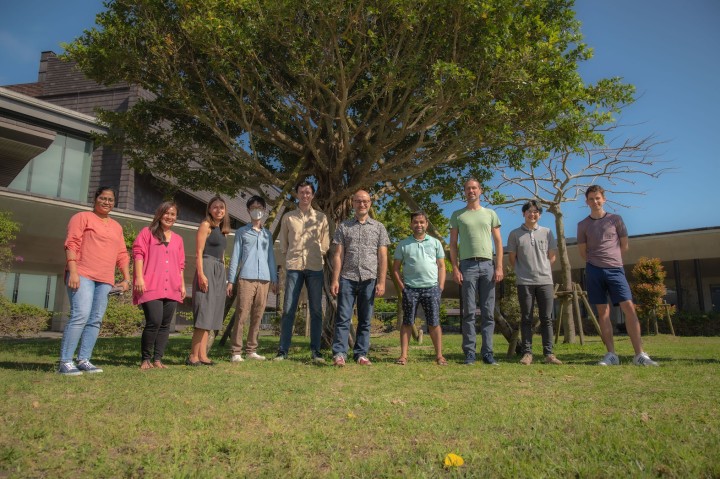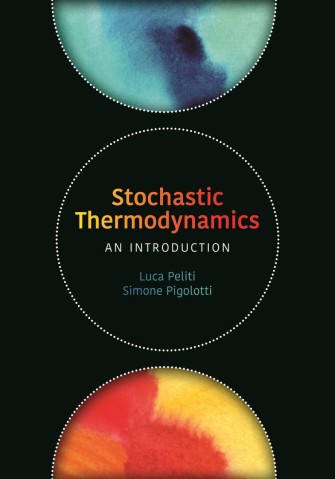Biological Complexity Unit
Associate Professor Simone Pigolotti
BCU in April 2022. From left to right: Shrabani Mondal, Kaori Yamashiro, Anzhelika Koldaeva, Qiao Lu, Samuel Cure, Simone Pigolotti, Deepak Bhat, Florian Pflug, Ryo Nakatani, Robert Ross.
Abstract
The Biological Complexity Unit at OIST studies biological and biophysical systems that evolve stochastically. FY2020 has been the fourth year of activity of our Unit, that has been growing in size and productivity. Our main research lines in biophysics are the understanding of non-equilibrium mechanism of error correction in biology and modeling extended microbial populations at individual-based level. A third research line is in statistical physics and in particular in stochastic thermodynamics.
1. Staff
- Prof. Simone Pigolotti, Associate Professor
- Dr. Robert Ross, OIST Interdisciplinary Postdoctoral Fellow
- Dr. Deepak Bhat, Postdoctoral Scholar
- Dr. Shrabani Mondal, Postdoctoral Scholar
- Dr. Florian Pflug, Postdoctoral Scholar
- Ms. Anzhelika Koldaeva, PhD Student
- Mr. Qiao Lu, PhD Student
- Mr. Samuel Cyrus Cure, PhD Student
- Ms. Kaori Yamashiro, Research Unit Administrator
2. Collaborations
2.1 Bacterial growth in microchannels
- Description: We are collaborating with the Micro/Bio/Nanofluidics Unit at OIST to understand bacterial growth in microchannel from a theoretical and experimental perspective.
- Type of collaboration: Joint research
- Researchers:
- Prof. Amy Shen (OIST)
- Dr. Hsie-Fu Tsai (OIST)
2.2 Speed variations of bacterial replisomes
- Description: We have collaborated with the Nucleic Acid Chemistry and Engineering Unit at OIST to understand the dynamics of bacterial replisomes theoretical and experimental perspective.
- Type of collaboration: Joint research
- Researchers:
- Prof. Yohei Yokobayashi (OIST)
- Dr. Samuel Hauf (OIST)
- Dr. Charles Plessy (OIST)
2.3 Cellular energetics
- Description: We are continuing an internationa collaboration to understand the energy consumption and dissipation of cells using non-equilibrium thermodynamics.
- Type of collaboration: Joint research
- Researchers:
- Prof. Matthias Heinemann (University of Groningen, Netherlands)
- Dr. Pablo Sartori (Gulbekian Institute, Lisbon, Portugal)
- Dr. Jonathan Rodenfels (MPI-CBG, Dresden, Germany).
3. Activities and Findings
3.1 Population genetics in microchannels
Population genetics of well-mixed microorganisms is well understood. Much less is known about population genetics of microorganisms in confined space. In this project, we proposed a model for bacterial competition in microchannels where reproducing cells push entire lanes of cells, leading to expulsions of other bacteria from the channel. Our theory predict that the outcome of this dynamics is a fast diversity loss in the direction of the channel and a much slower loss in the ortogonal direction. Experiments from our collaborators in the Micro/Bio/Nanofluidics Unit at OIST confirm this prediction (see Fig. 1). Our results illustrate a fundamental mechanism underlying biological competition in confined structures (A. Koldaeva, H. Tsai, A.Q. Shen, S. Pigolotti, "Population genetics in microchannels", Proc. Natl. Acad. Sci. 119 (12) e2120821119 , 2022)
3.2 Search and localization dynamics of the CRISPR/Cas9 system
Important proteins need to find specific locations on the DNA to perform their biological function. In this project, we considered a model of DNA sliding and detaching of Cas9, a central protein of the CRISPR/Cas9 system. The model, fitted to experimental data (See Figure 3), supports that Cas9 slides, but with a short sliding length. We then studied the search problem on a long DNA containing a large number of targets. We found that this problem can be analyzed by applying the theory of Anderson localization. Our results rationalize recent experimental results and provide a fresh viewpoint on the problem of DNA target search (Q. Lu, D. Bhat, D. Stepanenko, S. Pigolotti, "Search and localization dynamics of the CRISPR/Cas9 system", Phys. Rev. Lett. 127, 208102, arXiv/2103.10667 , Featured in Physics, 2021).
3.3 Generalized Euler-Lotka equation
The cell division time of growing unicellular organisms displays significant fluctuation, even for genetically identical individuals. The distribution of cell division time is related with the fitness by the so-called Euler-Lotka equation. A crucial assumption of the Euler-Lotka equation is that the reproduction times of different cells are statistically independent. Recent experiments have proven that, in most bacterial colonies, this is not the case. We rigorously proved a generalization of the Euler-Lotka equation which remains valid for correlated cell divisions. By applying the result to experimental data (see figure 3), we found that these correlations have a large enough effect to be appreciable in experiments (S. Pigolotti, "Generalized Euler-Lotka equation for correlated cell divisions" , Phys. Rev. E (Letter) 103, L060402 (Editors' Suggestion), arXiv/2101.02403 , 2021).
3.4 Stochastic Thermodynamics: An Introduction
Our introductory book on Stochastic Thermodynamics was published during this fiscal year. It provides a pedagogical introduction to this field (L. Peliti, S. Pigolotti, "Stochastic Thermodynamics: An Introduction". Princeton University Press, 2021)
4. Publications
4.1 Journals
- A. Koldaeva, H. Tsai, A.Q. Shen, S. Pigolotti, "Population genetics in microchannels", Proc. Natl. Acad. Sci. 119 (12) e2120821119 (2022).
- Q. Lu, D. Bhat, D. Stepanenko, S. Pigolotti, "Search and localization dynamics of the CRISPR/Cas9 system", Phys. Rev. Lett. 127, 208102, arXiv/2103.10667 , Featured in Physics, (2021).
- J.M. Miotto, S. Pigolotti, A.V. Chechkin, S. Roldán-Vargas, "Length scales in Brownian yet non-Gaussian dynamics", Phys. Rev. X 11, 031002 , arXiv/1991.07761, (2021).
- S. Pigolotti, "Generalized Euler-Lotka equation for correlated cell divisions" , Phys. Rev. E (Letter) 103, L060402 (Editors' Suggestion), arXiv/2101.02403 (2021).
- Y. Kinjo, N. Lo, P. V. Martín, G. Tokuda, S. Pigolotti, T. Bourguignon, "Enhanced Mutation Rate, Relaxed Selection, and the “Domino Effect” are associated with Gene Loss in Blattabacterium, A Cockroach Endosymbiont", Molecular Biology and Evolution, msab159, (2021).
- X. Yang, M. Heinemann, J. Howard, G. Huber, S. Iyer-Biswas, G. Le Treut, M. Lynch, K. L. Montooth, D. J. Needleman, S. Pigolotti, J. Rodenfels, P. Ronceray, S. Shankar, I. Tavassoly, S. Thutupalli, D. V. Titov, J. Wang, and P. J. Foster, "Physical bioenergetics: Energy fluxes, budgets, and constraints in cells". Proc. Natl. Acad. Sci. (Perspective), 118 (26) (2021).
4.2 Books and other one-time publications
L. Peliti, S. Pigolotti, "Stochastic Thermodynamics: An Introduction". Princeton University Press, (2021)
4.3 Oral and Poster Presentations
- Pigolotti S., “Information processing in cells: from CRISPR to replisomes”, invited seminar, hybrid workshop “Frontiers in Theoretical Biophysics”, APCTP (South Korea), 17 November 2021.
- Pigolotti S.. “Dynamics of Bacterial replisomes”, American Physical Society (APS) March Meeting, 15 March 2022.
- Koldaeva, A., “Population genetics in microchannels”, American Physical Society (APS) March Meeting, 16 March 2022.
- Lu Q., “Search and Localization Dynamics of the CRISPR-Cas9 System”, American Physical Society (APS) March Meeting, 16 March 2022.
- Mondal, S., “Optimality in biological proofreading”, American Physical Society (APS) March Meeting, Invited Focus Session Speaker, 18 March 2022.
5. Intellectual Property Rights and Other Specific Achievements
Nothing to report.
6. Meetings and Events
Nothing to report.
7. Other
Nothing to report.









